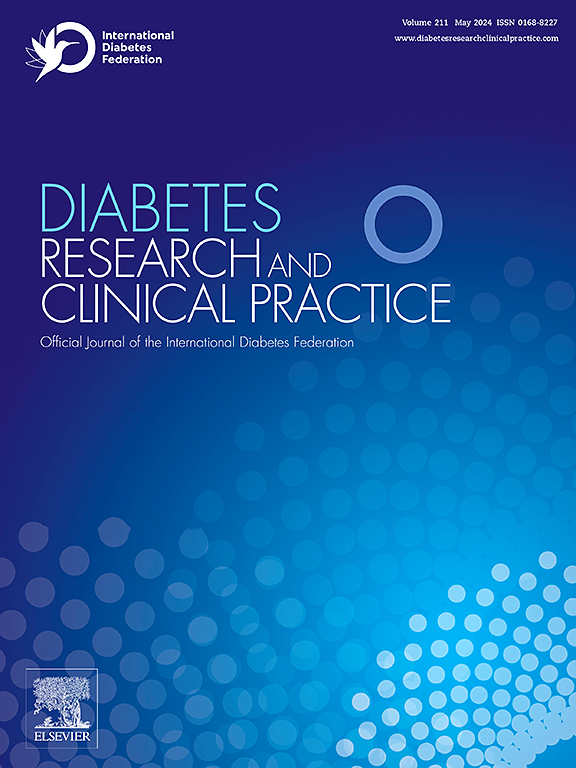用睡眠和体育活动代替久坐时间:与 2 型糖尿病患者的身体功能和健康的关系。
IF 6.1
3区 医学
Q1 ENDOCRINOLOGY & METABOLISM
引用次数: 0
摘要
目的:研究以睡眠、轻体力活动(LPA)或中强度体力活动(MVPA)代替久坐行为(SB)与身体功能和健康的关系:方法:研究纳入了 808 名 2 型糖尿病(T2DM)成人的横断面数据。通过加速度计确定 24 小时的行为。采用等时替代法来估算运动替代其他 24 小时行为对身体功能和健康指标的理论影响:结果:将 30 分钟的体育锻炼重新分配到睡眠中与坐立-60(STS60)和杜克活动状态指数(DASI)得分分别提高 1.0%(95% CI:0.1-1.9)和 1.2%(0.1-2.3)、降低 3.6%(1.5-5.5)和 1.9%(0.1-3.7)有关。而用 MVPA 代替 SB,STS60 和 DASI 分数分别提高 3.8%(2.2-5.4)和 3.9%(2.0-5.9),PHQ9 分数降低 4.7%(0.3-9.0)。用 LPA 取代 SB 可使 PHQ9 评分降低 4.1%(1.0-7.1):对于患有 T2DM 的成年人来说,理论上用睡眠和体育锻炼(尤其是 MVPA)替代 SB 与身体功能和健康指标有关。在健康方面,睡眠(抑郁)的相关性与 MVPA 的相关性相当或更强(糖尿病困扰)。本文章由计算机程序翻译,如有差异,请以英文原文为准。
Replacing sedentary time with sleep and physical activity: associations with physical function and wellbeing in Type 2 diabetes
Aims
To examine the associations of substituting sedentary behaviour (SB) for sleep, light physical activity (LPA) or moderate-to-vigorous physical activity (MVPA) with physical function and wellbeing.
Methods
Cross-sectional data from 808 adults with Type 2 Diabetes Mellitus, (T2DM) were included. 24-hour behaviours were ascertained through accelerometery. Isotemporal substitution was used to estimate the theoretical substitution of SB for other 24-hour behaviours on associations with physical function and wellbeing markers.
Results
Reallocating 30 min of SB to sleep was beneficially associated with 1.0% (95% CI: 0.1–1.9) higher sit-to-stand-60 (STS60) and 1.2% (0.1–2.3) Duke Activity Status Index (DASI) scores, 3.6% (1.5–5.5) lower Patient Hospital Questionnaire-9 (PHQ9) and 1.9% lower (0.1–3.7) Diabetes Distress scores. Whilst substituting SB with MVPA was associated with 3.8% (2.2–5.4) higher STS60 and 3.9% (2.0–5.9) DASI scores, and 4.7% (0.3–9.0) lower PHQ9 score. Replacing SB with LPA was associated with 4.1% (1.0–7.1) lower PHQ9 score.
Conclusion
In adults with T2DM, theoretically replacing SB with sleep and physical activity, particularly MVPA is beneficially associated with markers of physical function and wellbeing. For wellbeing, associations for sleep were comparable (depression), or greater (diabetes distress), than for MVPA.
求助全文
通过发布文献求助,成功后即可免费获取论文全文。
去求助
来源期刊

Diabetes research and clinical practice
医学-内分泌学与代谢
CiteScore
10.30
自引率
3.90%
发文量
862
审稿时长
32 days
期刊介绍:
Diabetes Research and Clinical Practice is an international journal for health-care providers and clinically oriented researchers that publishes high-quality original research articles and expert reviews in diabetes and related areas. The role of the journal is to provide a venue for dissemination of knowledge and discussion of topics related to diabetes clinical research and patient care. Topics of focus include translational science, genetics, immunology, nutrition, psychosocial research, epidemiology, prevention, socio-economic research, complications, new treatments, technologies and therapy.
 求助内容:
求助内容: 应助结果提醒方式:
应助结果提醒方式:


